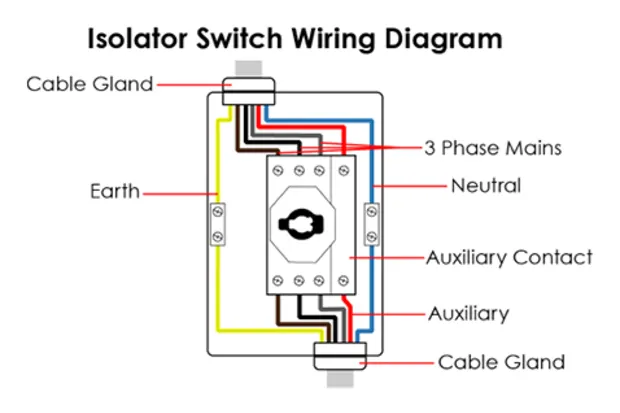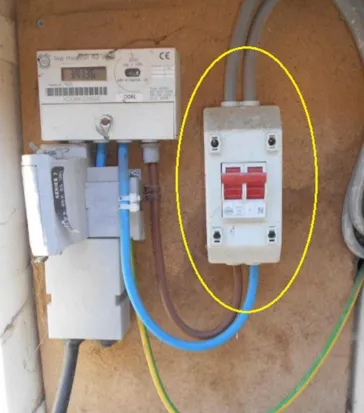Ever wondered how electrical systems are safely maintained?
An isolator switch is a critical device that disconnects power, ensuring safe maintenance.
Understanding its functions and applications is essential for any electrical setup.
What is an isolator switch?
An isolator switch is a mechanical switching device used to disconnect electrical circuits from power sources. It provides a visible break in the circuit to ensure safety during maintenance or repairs.
Isolator switches are designed to be operated only when the circuit is de-energized. They lack arc suppression capabilities and cannot interrupt load currents or fault currents.
Isolator switches are essential safety devices in electrical systems. They are typically installed near circuit breakers, meters, and consumer units to allow isolation of specific circuits.
Proper installation and use of isolator switches is critical for electrical safety. Only qualified personnel should operate these devices following appropriate lockout/tagout procedures.

How does the isolation switch work?
An isolation switch functions by physically disconnecting an electrical circuit from its power source. When activated, it creates a visible break in the circuit, ensuring no current can flow through.
The switch contains movable contacts that separate when opened. This creates an air gap between the contacts, preventing electrical flow. The gap must meet minimum clearance distances based on the voltage rating.
Most isolation switches are manually operated using a handle or lever. When turned to the “off” position, internal mechanisms separate the contacts. Many include a locking mechanism to prevent accidental reconnection.
For safety, isolation switches are designed to only open circuits under no-load conditions. They lack arc suppression capabilities found in circuit breakers. Proper procedure is to first de-energize the circuit using a circuit breaker before operating the isolation switch.
In three-phase systems, three-pole isolation switches simultaneously disconnect all phase conductors. Four-pole versions also disconnect the neutral. This ensures complete isolation of the downstream circuit.
Isolation switch wiring diagram
The disconnect switch wiring diagram illustrates the correct connections for installing an disconnect switch in a circuit. The following diagram shows the wiring of a typical disconnect switch.


What does the isolation switch do?
Isolation
An isolation switch provides a physical barrier between an electrical circuit and its power source. When activated, it completely disconnects the circuit, ensuring no current can flow. This function is crucial for safety during maintenance or repairs on electrical equipment. Isolation switches are designed to operate only when the circuit is de-energized, preventing accidental contact with live parts.
Visible Break
Isolation switches offer a clear visual indication of the circuit’s disconnected state. This visible break is a key safety feature, allowing maintenance personnel to confirm that the equipment is fully isolated from its power source before commencing work. The switch typically has a distinct open position that creates an air gap between contacts, providing a visible confirmation of isolation.
Switching Capability
While primarily designed for isolation, these switches also possess limited switching capabilities. They can make and break electrical connections under no-load or very light load conditions. However, isolation switches lack the arc suppression mechanisms found in circuit breakers, limiting their ability to interrupt significant currents. For this reason, they are typically used in conjunction with circuit breakers or other protective devices in electrical systems.
What does the isolation switch look like?
The isolation switch is circled in yellow on this photo. It’s normally located inside your meter box.


Type of isolation switch
Load Break Switches
Load break switches are designed to interrupt electrical current under load conditions. These devices can safely make and break electrical circuits carrying normal load currents. Load break switches typically feature arc extinguishing mechanisms to manage the electrical arc created when breaking the circuit. They are commonly used in distribution networks and industrial applications where frequent switching of loads is required.
Rotary Isolators
Rotary isolators are manually operated switching devices that provide a visible break in the electrical circuit. They feature a rotating handle that moves contacts to open or close the circuit. Rotary isolators are often used in low-voltage applications and are available in various pole configurations. These switches are valued for their simplicity, reliability, and clear visual indication of the switch position.
Enclosed Isolators
Enclosed isolators combine the functionality of an isolation switch with a protective enclosure. These devices are designed to provide a high level of safety and environmental protection. The enclosure typically offers ingress protection against dust and water, making enclosed isolators suitable for outdoor or harsh industrial environments. They often include features such as padlockable handles for added security during maintenance operations.
The price of the isolation switch
The price of a circuit breaker depends on its type and rating. Typically, a standard single-pole circuit breaker costs between $20 and $100. For multi-pole switches, the price range starts at about $100 and goes up based on the number of poles and ampere rating.
The price range of a circuit breaker also varies from manufacturer to manufacturer. Therefore, it is helpful to compare prices from different sellers before choosing one. Also, make sure that the circuit breaker manufacturer you choose offers good quality and reliability for a more lasting solution.
How do I install the isolation switch?
Installing an isolation switch requires careful attention to safety and proper procedures. Begin by turning off the main power supply to ensure a safe working environment. Select an appropriate location for mounting the switch, ideally near the circuit or equipment it will control.
Securely mount the isolation switch using the provided hardware. Connect the incoming power cables to the designated terminals on the switch, ensuring proper polarity. For the outgoing side, connect the cables leading to the circuit or equipment being isolated.
Use cable glands to secure all connections and prevent accidental loosening. Double-check all wiring to ensure correctness and tightness. Once installation is complete, restore power and test the switch’s functionality.
Label the isolation switch clearly to indicate its purpose and the circuit it controls. This aids in quick identification during maintenance or emergencies. Always consult local electrical codes and manufacturer instructions for specific requirements.
FAQs
1.Should my isolator switch be on or off?
An isolator switch should be off when performing maintenance or repairs. It should be on during normal operation. Always follow safety protocols and manufacturer instructions when operating isolator switches.
2.How do I know if my home is suitable for an isolator switch?
Most homes are suitable for isolator switches. They are essential for safety in electrical systems. Consult a licensed electrician to assess specific needs and ensure proper installation according to local electrical codes.
3.Are there any dangers associated with using an isolator switch?
Improper use of isolator switches can lead to electrical shock or fire. Risks include incorrect installation, faulty equipment, or operating the switch under load. Always follow safety guidelines and manufacturer instructions when using isolator switches.
In Conclusion
Isolator switches are crucial safety devices in electrical systems. They provide a visible break point, ensuring circuits are safely disconnected during maintenance or repairs.
Understanding and properly using isolator switches is essential for preventing electrical hazards and ensuring workplace safety.
Consult a qualified electrician to determine if your electrical system requires an isolator switch installation.
